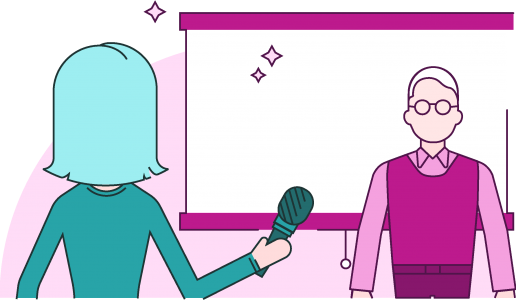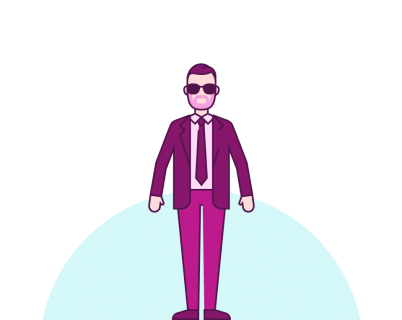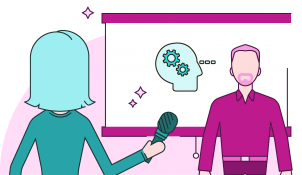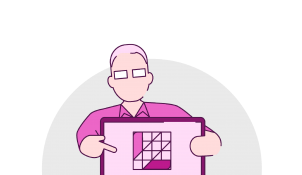Jamie Garroch puts the ‘power’ in PowerPoint add-ins. He’s written code for dozens of amazing functionality boosters, some for specific organizations and some available for all users, and he's joining the BrightCarbon team! Read on to learn about the experience that Jamie is bringing to BrightCarbon and how it will help clients and the presentation community use PowerPoint more effectively.
Insights from an eLearning strategist: Q&A with Clark Quinn
- Written by: Kieran Chadha
- Categories: Effective eLearning, Industry insights

Clark Quinn is a learning technology, design, and strategy consultant in the San Francisco Bay Area. He has made a career out of aligning corporate and organizational goals with learning science and computer science. As you can imagine, this experience has given him a wealth of knowledge on the elements of effective eLearning and development programs. Clark kindly agreed to let me pick his brain and find out what led him down the path to melding together technology and education disciplines.
Your undergrad is in computer learning and your PHD is in cognitive psych – can you talk about what made these two disciplines come together for you? Was this something a lot of people were doing or did you come up with this on your own?
I was going to do marine biology and as many of us do, I changed majors. I was tutoring on campus for extra money—calculus, physics, chemistry—then I got into computer science and ended up doing computer support for the tutoring office. I saw a connection between computer science and learning and I said, could this be a thing? So, I found out it was indeed a thing; at least it was a thing at other universities but not mine. My college had a program where you could design your own major. So, I ended up designing my own major in computer learning and that’s been my career ever since.
My first job out of college was in designing and programming educational computer games, which is where this whole notion of engagement and learning meshing together got its start and led to my book on the topic, Engaging Learning. When I was designing the games I realized we didn’t know enough how to design then, and I read about this thing called cognitive engineering and said, ‘Wait that’s what I want to do!’ I wanted to apply cognitive science to the design of systems, particularly learning systems. So, I asked the guy who wrote the article where I could study it and I ended up studying with him. The whole lab was about applied cognitive science—taking what we know about cognitive science and applying it to the design of systems—and my twist on it was applying it to learning systems. So that’s where it really intersected – taking what we know about how we think work and learn and applying it to make organizations and people work smarter.
Do you feel like you are kind of a pioneer? Do you think people are doing this more now?
I can’t say completely that I’m a pioneer—the AI and education field was trying to apply cognitive science to learning too—but it hasn’t penetrated mainstream well. Instructional design is founded on scientific principles but it’s more behavioral psychology, and as we’ve transitioned to the cognitive, and even more post-cognitive – situated and emergent learning views – we haven’t really seen as much of. There are a few people who are out there trying to make this more clear but it’s not as mainstream as it could be.
I am a campaigner for more learning science. The IEEE (Institute of Electrical and Electronics Engineers) is starting a new initiative to create a definition of what a learning engineer is. If you think of engineering as applying science to design, learning engineering is applying learning science to design. So, we’re getting a shift from the old school but it’s still relatively unpracticed.
Do you think this is why you’ve dedicated so much of your life to higher education? Because you were also a professor, correct?
Well, I was an academic for a number of years: I went and got a PhD and did a post doc, and I was hired to teach interface design. But I left higher education after the birth of our first child—we were in Australia and wanted to be closer to family—and I joined what was effectively a start-up.
Higher ed has been just as much or more of a focus for me as corporate and organizational learning, you know: government, Fortune 500, etc. I like to think that the principles of learning design are relevant from pre-K all the way up to organizational learning.
So, you’ve had a lot of different kinds of experiences. Can you describe when you had this idea to start your own business? Was there a specific gap in the industry that you wanted to cover? How did it take shape?
When the internet bubble burst [and my start-up closed] I needed a way to support my family. Consultant went from a euphemism for unemployed to a way of life and I’ve been consulting now for just short of 20 years. I’ve been fortunate that what I have to offer has been valuable to people.
Unfortunately, what I found out was learning and development was not respected because they were ‘just doing training’. People had just started throwing stuff up on the web and adding a quiz and calling it eLearning—it wasn’t very good. It was hard, and has continued to be hard, to get people to understand that the problem is the tools are aligned to content creation, and people say ‘well if it looks like school it must be learning’, even if it doesn’t even measure its impact on the business.
As things are changing faster, we can’t plan, prepare, and then execute. I have a pretty simple statement that I repeat: ‘L&D isn’t doing near what it could and should do, and what it is doing, it’s doing badly. Other than that it’s fine!’ I think there’s opportunity there for improvement and that’s where I focus.
Do you think this has changed shape since you first started or are you still roughly fighting a similar fight?
Sadly, I feel like I’m still roughly fighting a similar fight. You know it was not that many years ago that I got together with some colleagues who felt similarly and we created the series ‘eLearning manifesto’. We were just trying to boil it down to something sensible and make a stand and say ‘Here’s where we should be’. It got a wide swath of attention but I don’t think it had the impact we wished it had had.
Similarly, my second to most recent book was more on the strategy side of things and people liked it and talked about the ideas in it, but that was four years ago and only now are we beginning to feel like there’s some shift in that direction.
What kinds of attitudes and misconceptions about learning technology do you run into? If you could have all of your clients come to you with something they already knew, something that you didn’t have to convince them on, what would that be?
The first one is to recognize that ‘information dump and knowledge test’ isn’t going to lead to any meaningful change in peoples’ ability to do.
What strikes me as relevant specifically to what you at BrightCarbon do for your clients is help them to make their presentations more effective. There’s this simplistic notion that if we add good production value even on top of bad design that people will find it engaging and everyone will be happy. They might, but the correlation between what people think about the learning experience and the actual impact is .09, which is just zero with a rounding error.
My book Engaging Learning is about how to design serious games, but it was really about how do you make learning experiences hard fun which they can and should be. Look at the elements that make effective learning practice, and the elements that make engaging experiences, and they actually align quite well. If you can understand that alignment you can design much better learning, but until you do you can’t just put instructional designers and game designers in a room together and get out anything but chocolate covered broccoli! It doesn’t have to be full games, it’s lovely when it is; next to live-mentored real-practice that’s really the next best thing. But live-mentored real-practice is problematic for several reasons: it can be expensive and live practice before they’re ready can mean things blow up or people die.
If all this information is available to people and they know it, and conceivably have even read it, why do you think that people are not doing better? Is it money, or is it just hard?
It’s certainly more about time, and then money, than almost anything else. Think about the trajectory: we were doing stand-up training and the web came around and people got excited and nobody wanted to travel. So, they said ‘Okay we’ll put it up online and make it eLearning’, so we looked to make tools to do that but they didn’t want to spend a lot of money.
Also, somebody who had been good at their job whether it was sales or manufacturing – they took the best ones and made them trainers. Then they took the trainers and said ‘Okay we’re going to make eLearning.’ So you have these people who don’t really understand eLearning, and pressure to do this cheap and fast.
That has continued and continued and gotten worse and the tools have made it easy for you to take PDFs and PowerPoints and throw them up on the web and add a quiz and people therefore have said it shouldn’t take us more than a couple weeks to develop a course.
Thus, an individual designer is given a tool and a bunch of PowerPoints and PDFs and they don’t have the time to or the ability to even build branching scenarios, let alone think through what really good learning or practice would be, let alone to try and make it engaging or write a story around it, much as they might like to. The tools they have make it somewhat challenging, the fact that they don’t have the background experience combined with the time expectations makes it almost insurmountable.
A lot of my work has been working with companies trying to help them say ‘You’ve got this process. What are some of the smallest changes you can make that will make the biggest impact and have the learning you do actually stick when it’s needed and transfer to the appropriate situations so it actually will get used instead of washing over people and being gone 5 days later, and then it has no impact at all?’ People are throwing away money!
You’re helping them to get closer to what is ideal, in the most cost- and time-effective way?
It would be lovely to really get them to totally shift and rethink and worry about the actual impact. There are two messages:
1.Do better learning design. How can we do that in the most effective way? People aren’t going to throw out their processes, but can we fine-tune it without drastically impacting their cost and schedules?
But the other side is:
2.Start helping them see the bigger picture. Sometimes you don’t need a course, sometimes you just need a little job aid. Joe Harless famously said ‘Inside every bloated training course is a job aid struggling to get out’. Sometimes you’re better off connected to other people rather than trying to codify a course. Sometimes it’s better to curate than to create.
There are a lot of strategies that will increase our impact without necessarily spending more money on more courses and so the first thing to say is ‘Let’s do our courses better’, and the second thing to say is ‘Let’s take a look at the bigger picture and see how we can be smarter about using our resources in a more useful way’.
When you say re-shaping the way that we’re thinking about learning, what kinds of things do you hope click for your clients? What kinds of “aha moments” are on your wish list for your clients to walk away with?
I think the biggest one is ‘Oh my goodness, there’s this vast pool of talent that we’re not effectively tapping into. We’re controlling people instead of giving them meaningful work and allowing them to come up with new solutions to help us’. It’s a new rethink, but if people did rethink it they could start moving towards being an agile organization that will move faster.
That’s the opportunity that’s on the table; that’s the money that’s just being ignored. Jay Cross used to say ‘Learning to learn may be the best investment you can make for your people’. This day and age we’re increasing rate of change and decreasing resources. The only way that you’re going to succeed is to make the organization as a whole start learning through the people generating the understandings that will take them forward.
So, it seems like you’re behind this cause. I don’t get the sense that you’re the kind of person that’s in this for the money—this is something that you’re really passionate about. I noticed you’re involved in a couple of organizations, what are they and how did you come to be involved in them? How do you feel that you’re benefiting your business and the industry as a whole?
When I saw the connection between computers and learning as an undergrad, that’s become my passion ever since. I didn’t go to grad school and teach at university to become rich! I’ve always had the passion for helping people. I admit I like doing it through technology because I like playing with the latest shiny objects. Part of my grad school experience included a professor who talked about social learning so I’d had that sort of simmering in the background and as I worked with organizations I started recognizing how many times courses weren’t the answers they needed.
Then when I moved to the bay area I connected with Jay Cross who wrote the book on Informal Learning and he brought me into the Internet Time Alliance. He and I had worked together on the Meta Learning Lab and he was pushing social and informal learning, but he realized he was doing it alone! So, he put together several people who he wanted to work with but also people who really cared about it and that was Jane Hart, Harold Jarche, Charles Jennings, and myself. We were the Internet Time Alliance! We came together to try and make a stance about what mattered with the informal learning and the social learning. We still stay in touch and continue to develop a mutual understanding from our different perspectives.
With Change Agents Worldwide, Harold got connected to that and he brought me into that. Change Agents Worldwide is a collection of people that are very much thinking about how organizations could and should be changed to take advantage of this informal and social learning. People weren’t necessarily coming from the learning space, certainly some do, but also from organizational change, or operations, or a variety of places, but they’ve all sort of believed in this notion of moving from hierarchy—top-down, one person doing thinking for many—to ‘Let’s tap into the power of people, and how do we do that?’ Together we’re a global network with a number of members and people working in different ways, some in organizations some independent.
We’ve been going sort of from start to finish in your career but I’m going to ask you to look back for a minute. Since you’ve had this varied career path and done a couple different things, is there anything that you miss or that you’d like to do again?
What you tend to do as a consultant is drop in, review where people are, provide input and feedback and perhaps guide them. The one thing I miss most is being part of a team on an ongoing basis, taking a vision and executing against it and having ownership of it. That was something I was good at. I got students to do really interesting projects and then I led a project developing an adaptive learning system. I had a truly world-class team—that phrase is really overused and yet these people have been recognized in a variety of ways for fabulous work that they have done since then. One of the people working with me said ‘Working with you is like going to grad school’ and that was really cool because we were educating each other – I was learning from them too, and we got some really cool stuff done. I’ve been fortunate enough to work on some really cutting-edge projects.
As someone who is so knowledgeable about learning, I would imagine that kind of social learning would be something you enjoy.
It is. It’s all about applying what we know about getting the best out of groups of people in ways that they’re enjoying, too, so we’re all having hard fun which is really the ultimate.
To learn more about Clark Quinn’s consulting company Quinnovation please click here.
Leave a comment
Kieran Chadha
Principal consultant; Head of BrightCarbon Academy
View Kieran Chadha's profileRelated articles
Insights from a graphics guru: Q&A with Mike Parkinson
An interview with Mike Parkinson, PowerPoint MVP, author, and businessman. Read how he juggles all his priorities, and how he views slow and steady growth as the key to his success.
- Presentation technology / Industry insights
- Comments: 2
think-cell is a PowerPoint add-on with chart and layout automation functions. Their latest update includes big data reporting capabilities and automatic layout generation. We got a special sneak preview of the latest version, and the inside scoop on the best features of the update from CEO and co-founder Markus Hannebauer.
Join the BrightCarbon mailing list for monthly invites and resources
Tell me more!As we were novice and non-marketing professionals, everyone took the time to explain and teach while also doing, which came in handy to feel more comfortable with what we were creating.
Marc Chaanine Jamaica Bearings



